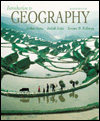 |  Introduction to Geography, 8/e Arthur Getis,
San Diego State University
Judith Getis
Jerome D. Fellmann,
University of Illinois, Urbana-Champaign
Cultural Geography
Objectives:After reading and studying this chapter you should be able to:
1.
Define the components of culture and be able to differentiate between them.
|
 |  |  | 2.
Explain how interaction of people and their environment helps to define culture and create a cultural landscape.
|
 |  |  | 3.
Identify the component subsystems of a culture.
|
 |  |  | 4.
Identify major world cultural hearths and the chief centers of plant and animal domestication.
|
 |  |  | 5.
Enumerate conditions that both promote and retard diffusion of cultural traits.
|
 |  |  | 6.Be able to place spatially the world's major religions and languages. |
 |  |  | 7.
Understand the role of language and religion in cultural identification, cultural change and cultural diffusion.
|
 |  |  | 8.
Describe the spatial diffusion of the major religions through history and identify which forms of diffusion were dominant under certain historical conditions.
|
 |  |  | 9.
Define ethnicity and discuss territorial segregation.
|
 |  |  | 10.
Defend the arguments against race and environmental determinism as valid concepts in the study of cultural geography.
|
 |  |  | 11.
Understand the role of gender in various societies and discuss how it can be linked to economic development.
|
 |  |  | 12.
List the major indicators of cultural diversity at the global level and plot their spatial distribution on a map.
|
 |  |  | 13.
Define culture realm and locate world culture realms on a map.
|
|



 2002 McGraw-Hill Higher Education
2002 McGraw-Hill Higher Education